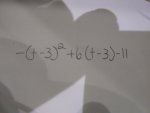Help Me simplify this equation... I need help with this
. . . . .-(t - 3)2 + 6(t - 3) - 11
I already know what the answer is, but no matter what website I go to; there always seems to be
a lack of explaination as to how to simplify it.
For example
https://www.mathpapa.com/algebra-calculator.html
gives a step by step explaination, but random numbers seem to pop out of nowhere.
I used FOIL manage the squared paranthesis.
Please help Me and give a spoonfed, step by step explaination on how You solved this. ^^
. . . . .-(t - 3)2 + 6(t - 3) - 11
I already know what the answer is, but no matter what website I go to; there always seems to be
a lack of explaination as to how to simplify it.
For example
https://www.mathpapa.com/algebra-calculator.html
gives a step by step explaination, but random numbers seem to pop out of nowhere.
I used FOIL manage the squared paranthesis.
Please help Me and give a spoonfed, step by step explaination on how You solved this. ^^
Attachments
Last edited by a moderator:

